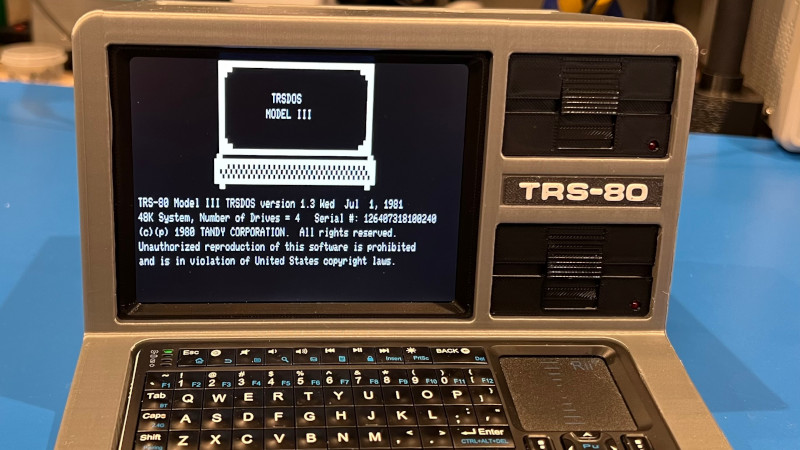Among the 8-bit home micro boom from the late 1970s through early 1980s, the introduction to computing for many wasn’t a pricey Apple or Commodore, instead it was the slightly lower budget machine from Radio Shack. The TRS-80 series of computers live on and have a loyal following among retro computing enthusiasts. But like all such machines the original hardware is harder to find in 2024, so how about the TRS-80 experience without the failing vintage parts? The FauxTRS from [Jpasqua] is just that, the feel of a Model 3 or Model 4, powered by a Raspberry Pi.
In a sense then, this is a very well-designed case for a Raspberry Pi that looks a lot like the Tandy of old. With a modern LCD and keyboard it could just as easily be a normal desktop machine, but when the emulator fires up it does indeed look very much like a small version of the real thing. You can download the STL files from Printables, and for the cost of a few extra parts you can have one too.
Alternatively, if a faux TRS doesn’t do it for you, there’s always the chance of making a more real one.
















Guys, I really appreciate those model making efforts but after all those yeaes, could you please start to pay the CRT the tribute it deserves?
Using an LCD as a substitute is all nice and soft and warm, but to a faithful replica also belongs the CRT.
You should at least try to install a magnifier glas, some sort of foil or consider running a software simulation of a CRT.
Because without the CRT, a big part of the personality of old computers is missing.
It’s not a preference, but simply a fact. There will be a time in which people nolonger have access to a real CRT, so preserving this aspect is urgent.
You know, you could always do it if it bothers you so much.
Probably, but it’s not about me. I can’t supervise all the model makers, either. ;)
Seriously, though, it’s a bit saddening to see that models nearly always lack a proper representation of the monitor.
Despite both the keyboard and the monitor being the parts the users did interact the most with.
That’s as if making models of air planes and not bothering to ever include a propeller.
I forgot, I didn’t mean to criticize this project here in particular.
It was rather meant as a comment about model making in general.
My apologies if the author felt hurt because of this, it wasn’t intended that way.
Try cool-retro-term … I run this when working with my PiDP 11/70.
These old machines had poor performance, they weren’t very reliable, had limited connectivity, and were often hamstrung by their ROM software.
But they opened up a new world for millions of people in the 1970’s and 1980’s. And for that I will will remember them fondly.
I feel same. I often like to think of them as programmable terminals, rather than computers.
Looking at it this way gives me peace of mind.
Commodore? Pricey? Hardly.
It was for me back then, until I found a VIC-20 at a pawn shop ($30?)
Not a great deal for ’98.
I don’t think the monitor is an issue, but the TRS80’s had pretty good mechanical keyboards. But even the coco1 keyboard is better than the tiny clicky horror used in this build. Surely there must better a better alternative??
“I don’t think the monitor is an issue, but [..]”
Hi there! 😃 That’s an understandable phenomenon, I think.
There are usually two bigger groups who don’t have an issue with it, I think.
One group is the 60+ generation, which is into the latest tech and admires anything flat screen and everything small and black..
And secondly, there are the youngsters below 25 which never had seen a retro system in original condition and grew up with flat screens.
And then last but not least, there are the modern CRT fans who are into RGB, scan doublers and scan lines.
They mean good, but are being mislead by the arcade fans and the idea that all old computers had thick black scan lines and pixel graphics.
They rarely if ever had the home computer experience on a black/white household TV, a green monitor or an 80s era 14″ color TV (portable, camping tv). Or on a Commodore 170x video monitor.
(There’s also ‘Generation C64’, but its members have various opinios about CRT monitors. Some love them, some don’t, some don’t care.)
Cool‐retro‐term is the result of this, I think.
It’s a good simulator, really, but the default settings are overkill.
They are the manifestation of a CRT stereotype that never was real.
The flickery screens with all the shaking and scan lines are a clichè.
And that’s exactly the reason why I made the original comment about paying CRTs tribute.
In a few years, these miniature models might be all what remains from the real systems.